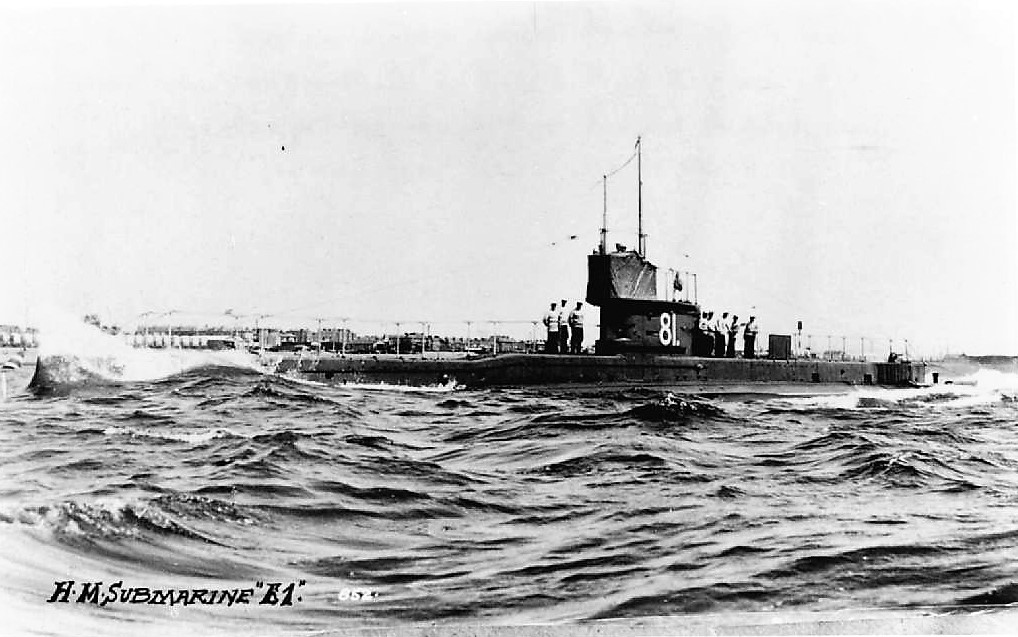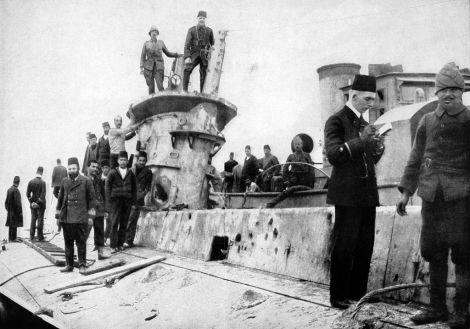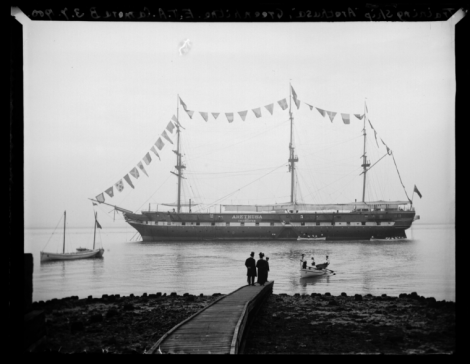Gallipoli, James Bond 1915 style, from Peckham to a Turkish Prison Camp

Chimney Sweeps and The Workhouse
On 12th March 1887 Henry William Trimmer was born to a family of Chimney Sweeps, he was my Grandmother’s brother. He was the 4th Henry William in a direct line of henry Williams. His Father, Henry William the 3rd had been born in Leytonstone workhouse, one of the most notorious in England. Official reports told stories of children so malnourished that they drank from soapy puddles in the laundry to try to get by. His itinerant Chimney Sweep Father, Henry William 2nd had rescued him, his half Brothers and Mother, and the boys had gone to South London where they were apprenticed to the harsh world of boy chimney sweeps.

Henry William 2nd had enough of this and in the 1880s joined the Royal Marines at Chatham, it isn’t clear if he saw action, and his records seem to have gone missing, but he managed to get Eliza Sanders, the sister of one of his friends in the Royal Marines pregnant in 1883, her baby would be my Grandmother. A year after she was born the couple married, and Henry William 2nd left the Marines, and set up home, itinerantly moving from lettings to lettings in Peckham, Camberwell and Lambeth. They had eight children but it is their first son, and second child Henry William 4th whom we are concerned with here.
Hard Times, but The Royal Navy to the Rescue
Times were hard, the family were constantly on the move from rented digs to rented digs, doing a “midnight flit” every time the rent money ran out, they possessed hardly anything, so loading up and moving on didn’t take long. Henry William had been apprenticed to a Fishmonger at 14, but that had not come to anything, and he ended up destitute but had the good fortune to be taken on to the TS Arethusa (Royal Navy Training Ship Arethusa), moored at Greenhithe on the South Bank of the Thames, and known as refuge for homeless and destitute Boys. It is most likely that his Father and Uncle’s service as Royal Marines had opened the way for him to be accepted.
Henry William’s time on Arethusa served him well, as in 1905 as a man, on his 18th birthday, he signed up for the Royal Navy at his Father’s old depot of Chatham, just further downriver from Greenhithe, and worked his way up from Boy, to Ordinary Seaman, to Able Seaman, to Leading Seaman. And what a career he had in 1905 aged 18 he sailed to China on HMS Hogue, and spent a year at sea, coming home with a tatoo of a Japanese “Lady” on his right bicep!
On his return, after some retraining, he started his career as a submariner, first posted to HMS Thames, a Submarine support ship, then Vulcan and Hebe, similar ships. With the birth of his first daughter, Irene Florence in 1911, Henry purchased his exit from the Navy moved back to South East London, but joined the Royal Fleet Reserves, ready for call up if required, and sure enough, come the outbreak of hostilities in 1914 Henry William was back in the Navy aboard Submarine E15. His family followed him to the Royal Naval Dockyards at Sheerness on the Isle of Sheppey in Kent, and his last daughter Dorothy was born there in 1914.
Submarines
Henry William was bright and able and experienced. He was posted directly to a brand new Submarine E15 looked after by the Dolphin depot ship.
The Commanding Officer of Submarine E15 was Lieutenant Commander Theodore Stuart Brodie whose twin brother Lieutenant Commander Charles G Brodie commanded another Submarine. The twins were nicknamed ‘Dummy Head’ and ‘War Head’ respectively by their men and fellow officers, mimicking the Naval terms for armed Torpedoes and practice Torpedoes. Unfortunately for Henry he got Dummy Head as his Captain. Despite his career commanding submarine’s C36, C33, and D8, Dummy Head did not get his nickname without reason. Submarine E15 would have one of the shortest careers of the 56 E Class Submarines in action during WWI.

Initially Henry served aboard her with the North Sea Fleet based out of Harwich. Dummy Head’s lack of luck led to Able Seaman George Morris being lost overboard in November 1914; losing a man overboard from a submarine certainly takes some doing. In 1915 E15 was sent with a flotilla of submarines to the Mediterranean, including AE2 an Australian Sub of the same class, they were serviced by HMS Adamant. At the Island of Lemnos, they were joined by Lieutenant Clarence Edward Stanhope Palmer RNVR, he had previously been with the diplomatic corps at Chanak in Turkey, and to all intents and purposes was a Government Special Agent, gathering knowledge of the entrance to the Dardanelles, the location of Turkish Sea Mines, and fluent in the Turkish language, he was an early James Bond type figure, brought in for what appears to be a secret mission on E15, it being remarked on how insistent he was with Captain Brodie to make sure he got on board as “an extra hand”. That night they sailed for the Dardanelles.

Stealthily E15 inched through the straits to get into Turkish waters in the Sea of Marmora, as the spearhead of an allied invasion force. However despite having Clarence Palmer on board to help with the approach to the channel, Captain Brodie and the ship’s navigator, managed to have the E15 steered into a strong current which its silently operating electric engines were not strong enough to counter, at 07.00 on 17th April 1915 the Ship’s Telegraphist recorded :
“Everything going well until about 7am when we struck and, despite all that could be done, we were soon high and dry. The Turkish batteries then opened fire on us one large shell entering our conning tower and killing Captain Brodie as he was going on the bridge. Several shells came through the boat, one entering the engines and bursting several oil pipes, thick smoke began to come from aft, but we could not see what had happened there.
The men then began to go up the conning tower and through the shell hole and take to the water. The boat was about three-quarters of a mile from the shore and this distance we had to swim. Several men would not attempt it and I think it was because of this that so many were injured.”
E15 had run aground at Kephez Point, directly under the Guns of the Turkish Fort Dardanus, Electric Engines labouring vainly against the current. The Turkish shelling took out the unlucky Dummy Head Brodie as he climbed the conning tower to assess the situation, and five more crew were killed and seven injured by shelling and asphyxiation by smoke and chlorine gas released from the damaged electrical drive batteries onboard.
Around half a century later on a sunny morning in Silcote Road, just off the Old Kent Road, in Peckham, I sat with my Dad and Uncles as usual, reading the Victor comic, not knowing that my Great Uncle was featured in it.

But the story didn’t end with the shelling of E15.
Captivity
Henry was no slouch, he, with Clarence Palmer and most of the rest of the crew who were still in one piece, climbed up the conning tower and slipped out underwater through the shell hole before swimming the best part of a mile to shore, fortunately for them the same current that Dummy Head had led them to, took pity on them, and helped them make it to shore, where the Turks quickly surrounded them and took them prisoner. Their dead mates were buried on the beach. The Telegraphist writes again:
“After their capture the survivors were marched to Chenak (Chanak) and were kept in a cowshed overnight. The following day they were placed in better conditions. On Wednesday 21st April the survivors were put on a Gunboat at Chenak and were taken to Constantinople arriving on 22nd April and being taken to the Stamboul Prison.
Four days later, on Monday 26th April, the crew were taken to Haidar Pasha by ferry and then on to Ess Kicheher by train – where they stayed overnight. On the 27th April the train journey continued on to Afion Kara Hissar in the Asia mainland of Turkey and, on Wednesday 28th April they were moved into the Bermin Mosque School Camp.”
Henry spent the rest of the war in Turkish Prison camps, and would be joined by the crew of an Australian submarine that had been part of their original flotilla. Their treatment was generally OK by the Turkish soldiers, and they were regularly visited by the Red Cross, received food and provision parcels, some of which they traded with their Turkish guards to get information and News Papers to find out what was happening in the War. The men were fortunate to have Clarence Palmer with them, the secret service agent, who, being fluent in Turkish could speak with the guards and read the Turkish papers. Despite this, conditions were harsh, and one officer and seven men died during their captivity. But Leading Seaman Trimmer was a man from Peckham who had grown up with deprivation and hardship, he would get through the whole thing and return relatively unscathed considering what he’d been through.
Although the Turks treated the men and officers equally, it seems that the British Authorities didn’t. For at the end of the war our Secret Service Agent Clarence Palmer is decorated with the Distinguished Service Cross (DSC) for the part he played in the action, simply because he took on the mission knowing the dangers, which is funny really, as no such medals went to Henry Trimmer or his mates, it’s an indication of not only friends in high places, but perhaps a reward for a more covert mission? One Catholic Officer, Geoffrey Joseph Frederick Fitzgerald, the E15’s navigator had an intervention from the Pope that got him released early, with further decorations and cushy jobs after the war. Henry and his shipmates came home to no cushy jobs or outstanding decorations, they were just de-mobbed and set back on the streets. Even Dummy Head, who had got them wrecked and captured with about a dozen dead, was eulogised like a hero despite his incompetence. So the secret service agent who was onboard to give intelligence on the entrance to the Dardanelles, in terms of access and minefields, the Navigator who was meant to steer them through, and the Captain who was meant to use his judgement to keep them out of harm, i.e. the three men who effectively failed in their duties were eulogised while the men who suffered for their Officers’ joint failures got nothing. In the words of the music hall song that the men would have been aware of:
“It’s the same the whole world over,
It’s the poor what gets the blame,
It’s the rich what gets the pleasure,
Isn’t it a blooming shame!”
The picture below shows the crew after their capture. From what I can make out, Henry William Trimmer, my Great Uncle is the man standing with a face like thunder in the centre of the photo third prisoner from the right, behind and just to the side of the seated officer.
Embed from Getty ImagesWhile the men were being marched into captivity the British Navy set about destroying the evidence before the Turks and their German advisors could get too much intelligence about the E15. They had already boarded the stranded E15 as can be seen from the picture below.

The reason was given as being to stop the Turks salvaging, repairing, and re-commissioning the E15, which is definitely true, but the efforts the Navy went to were extreme, including shelling by warships, attacks with Torpedoes by other subs (including one with Dummy Head’s more competent brother “War Head” along for the ride), a bombing raid by aircraft, and finally a successful attack from small picket boats with torpedoes. A gigantic effort, and one where the submarine used to attack the wreck got stuck on the same bank that the E15 had, but managed to get itself free, so the risks were extreme. It begs the question; was this really just to keep E15 out of the Turk’s hands? Or perhaps there were other secrets onboard, associated with the mission of the Secret Service Agent? Perhaps Geoffrey Fitzgerald’s release at the request of the Pope was more than just compassion based for a fellow Catholic in hard times, perhaps he brought information with him from Clarence Palmer?
Home
When Henry William Trimmer came home, his story took further twists. He was obviously wily and resourceful, and managed to get himself made a Police Constable in Margate, no doubt using his Naval contacts as references. In 1921 he manages to use his contacts to finagle his way into the local Free Mason’s Lodge, causing a minor scandal at the time, and a letter was written from the Provincial Grand Lodge to the Local Lodge complaining about the initiation of “Brother Trimmer”, as it was done despite permission having been previously refused by the Chief Constable. This was put down to an “error” and Henry was allowed to retain his position, but was not allowed to be promoted to further positions without express permission from the Chief Constable. Why the Chief Constable refused him permission to become a Free Mason in the first place is unclear, but as much as you can take the boy out of Peckham, you can’t take Peckham out of the boy, and with a total lack of regard for the middle class rules, Henry gets in any way, and not only that but keeps his position in both Police and Free Masons. Well done Henry. Did he still have contacts people in high and dark places like Clarence Palmer?
In 1924 Henry has had enough of England, and moves with his family to Australia, to join his Mother and siblings who had gone out there in 1908, and where his Father had died whilst Henry was a POW in Turkey. Having spent time with the Australian prisoners in Turkey, perhaps Henry once again used his contacts help get out to the Antipodes? Henry would eventually die in Australia in 1969, having spent more than half of his life there.
There are obviously unanswered questions concerning the role of the E15, Clarence Palmer, and Henry’s relationship with him, perhaps one day Time Detectives will get to the bottom of it?
….oh, and just to top it off, one of the Stokers on E15 was called…..James Bond…what a happy coincidence!



Hey great read. I think this guy could be a relative of mine according to my sisters family history studies!
LikeLike
Hi Todd,
I believe he may well be, I’ll have a look later today and let you know if I can pin the relationship down.
LikeLike
Hi Todd,
If your sister is Keli Grose, then Henry William Trimmer is your Great Grand Uncle, or Great Great Uncle depending on which convention in naming generations you go along with, so he is your Great Grandmother’s brother. This makes you and me second cousins once removed.
Paul
LikeLike
Hi Paul, interested to find this post, Henry is my Great Grandfather, Irene Florence is my Grandmother. Please email me if you recieve this comment.
Regards Chris
LikeLike
Hi Chris, I’ve replied to the email sent with your comment, but it’s doesn’t look like a personal one. Can you confirm if you receive please? If not you can reach me on paulmcneil@timedetectives.co.uk
LikeLike
it is interesting and thank you for this information. I am living in Turkey Çanakkale , Dardanos. Dardanos is where they were taken prisoner.
LikeLike
Glad you liked the story Aytac, always interesting to understand the History of a place, and how things change over the years. I’m sure there are stories within the stories of what went on, but we can only scratch the surface. Best Wishes, Paul McNeil.
LikeLike
My father , Duncan Angus Matheson was a deep sea diver in the Dardanells, probably after the war and we have in our family the engine plate of E15 I have pictures of him during that time but the Naval Museums are not aware that divers had investigated the wrecks. There are photos but papers are long gone so we do not know whether he was in the Navy or the Merchant Navy.
LikeLike
What a great Story Aimee, any chance of you sharing copies of the photos? I’d be happy to have a look for the records for your ancestor in return?
LikeLike